It is difficult for the common man to perform conducts according to Vedas . To overcome this difficulty, the Puranas (The 18 sacred Holy texts compiled by Sage Vyas) make a mention of vrats. Let us understand various rules to be observed while performing vrats and their significance.
1. The need for foresight
The freedom fighter Swatantryaveer Sawarkar has said, “I did not undertake this vrat blindly”. This is absolutely true. A vrat should never be undertaken blindly. Lack of awareness and ignorance will not do here. One should accept a vrat knowingly.
2. Strict compliance
Any vrat should be followed meticulously. Once undertaken, we should not think of the hardships we may have to face when observing it.
3. Completion is necessary
If one begins a vrat, it should be completed; because if carelessly given up in the midst, the effects can be disastrous. This is what the scriptures preach. They also recommend ‘penance’ if there is a break in a vrat, deliberate or by accident. In today’s times penance itself is equivalent to repentance. If a vrat is broken by accident, one should fast for three days and men should shave off their hair and begin the observance once again.
4. Rules
A. Brushing of teeth
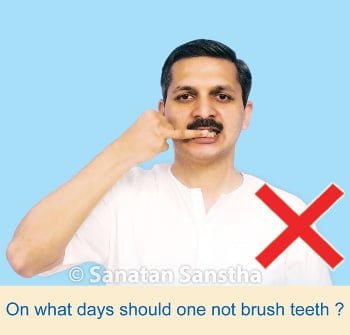
One should not brush teeth on the day of a fast or on a shraddha (Special rituals performed for the departed ancestors) day. If required then gargling with water, rinsing the mouth with water twelve times or cleaning the teeth with mango leaves, dried twigs or fingers is permissible.
B. Bathing
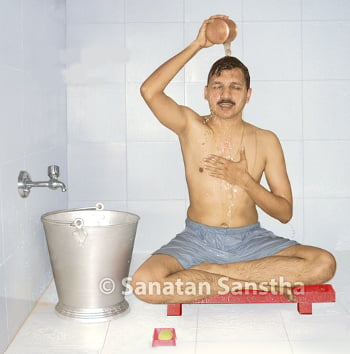
One should bathe everyday. It is necessary to bathe after passing flatus, crying or laughing loudly, losing temper, touching a rat or cat or lying.
C. Clothing and ornaments
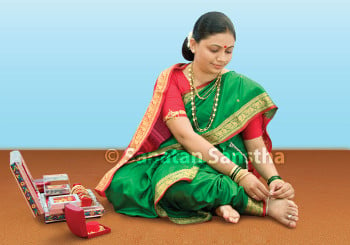
When observing a vrat we should use gandh (sandalwood paste), flowers, a chain of beads and clothing and ornaments to suit the vrat. When performing puja (Ritualistic worship) or a sacrificial fire etc. as part of a vrat, we should use an upper garment in addition to the lower garment. It is inappropriate to use more than two garments when reciting a mantra, chanting God’s Name, performing a sacrificial fire etc. This rule is made to prevent distress due to the heat generated in the body because of chanting God’s Name or the mantras . Whether a man or a married woman, throughout the vrat he / she should wear red clothing and fragrant white flowers. A Brahman (One who belongs to the first of the four varnas (Classes), studies scriptures and imparts knowledge to the society) should wear white coloured, a Kshatriya (One who belongs to the second of the four varnas, namely the warrior class) saffron coloured, a Vaishya (One who belongs to the third of the four varṇas and carries on some trade) yellow coloured and a Shudra either blue or any other coloured clothing. Wearing a dhoti with three folds is ideal. A Brahman wearing a dhoti is called Muniraj. It is inappropriate to wear a dhoti by tying a knot.
D. Chanting, eating meals and urination and defecation
Chanting, eating meals and urination and defecation should be done at the appropriate time.
E. Achman
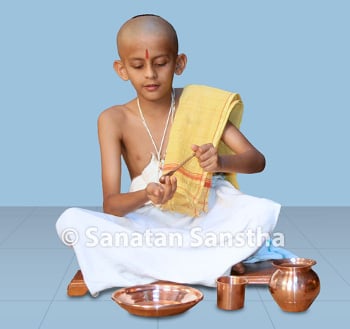
If one undertaking a vrat is entrapped in temptation or thought and forgets to do achaman, then his vrat is in vain. Even if one has done achaman earlier, one should do it again while bathing, eating or drinking or after returning home.
F. Puja of the Deity
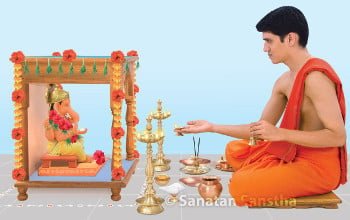
Puja of the Deity for whose sake the vrat has been undertaken should be performed. We should chant the Deity’s Name, meditate, listen to His / Her stories, worship, perform kirtans (narration of the glory of God through stories punctuated with devotional songs) and read religious texts.
G. Meals
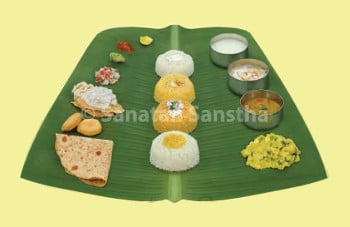
1. Should be limited. We should even avoid drinking water several times.
2. Havishyann (Food suited for offering in the fire) : Water, fruit, roots, milk, a Brahman’s wish, intake of medicines and a Guru’s command do not pose any obstruction to a vrat. Kheer (a sweet dish from milk) made for offering in a sacrificial fire, food collected by asking for alms, javas (a cereal), green leafy vegetables (bottle gourd, cucumber, fenugreek etc.), cow’s milk, curd, ghee, radish, mango, pomegranate, sweet lime, tangerine, banana etc. are food items suitable for eating during the vrat.
3. Salt, salty foods, honey and meat are prohibited.
4. Women and the Shudra class are not entitled to fast for more than two days.
H. Restrictions: One should refrain from doing the following things
1. Application of oil to the body and head, sabhyang snan (A Holy bath after applying oil, ubṭan to the whole body),
2. Eating betel leaves,
3. Application of fragrant substances to the body,
4. Actions which will decrease physical strength or aggravate mental disorders,
5. Anger, greed, attachment, laziness,
6. Smoking,
7. Sleeping during the day and
8. Stealing.
I. Observe celibacy
J. Travelling in a vehicle is prohibited
One performing a vrat should not travel on a bull, camel or donkey (meaning, not use any vehicle).
K. Careful cultivation of virtues
Carefully cultivate qualities like forgiveness, truthfulness, compassion, generosity etc.
L. Puja of the Guru, Deities and Brahmans
Puja of the Guru, Deities and Brahmans should be performed and they should be honoured.
M. Offering meals
Brahmans should be offered meals.
N. Offering meals to Married women and virgins
Married women and virgins should be offered meals.
O. Donation
Cattle, wealth, ornaments etc. should be donated.
P. Offering meals
The blind, poor and crippled should be offered meals. The Holy text Kalika-puran states that on the day of the vrat, delicious, sumptuous food and drinks should be generously distributed amongst orphans, the blind and the crippled. The ‘Bhavishya-Puran’ recommends that one following a vrat should offer meals to the blind, needy and helpless according to his capabilities.
Q. Ashouch
If one has made a sankalpa (Resolve or intent) to follow a vrat (vrata) many days in advance and at such time suddenly,
1. Ashouch occurs due to birth or death in the family, then it does not become an obstruction to the observance. If during the period of the vrat there is sutak (ashouch due to death in the family) then to get out of it, donation and puja have been recommended. In several vrats all the three – donations, Dharma and puja are included. In the vrats of Ganesh Chaturthi, Anant Chaturdashi and Ark-saptami, puja of the Deity of the vrat, van (Gift to a Brahman or married woman on religious occasions) and donations are advocated. Even if these vrats are interrupted by an ashouch, they can be continued; however donations should not be given, nor pujas undertaken.
2. Even if a woman gets her menses during a vrat, it does not pose any obstruction to her observance.
R. The comparative importance of
the code of conduct in relation to the acquired benefits
|
Achar |
Importance (%) |
Achar |
Importance (%) |
|---|---|---|---|
| 1. Sankalpa | 2 | 9. Food, bath etc. | 1 |
| 2. Ritualistic worship of Deity | 1 | 10. Day-to-day spiritual practice | 3 |
| 3. Welcoming the priest and offering dakshina (Offering in cash or kind, especially one given to a Brahman after a ritual) | 2 | 11. Actual Ritualistic act | 54
|
| 4. Serving food to the invited married women and kumarikas (A young girl, an unmarried girl) | 1 | 12. Fasting | 10 |
| 5. Offering food and garments to orphans/ destitutes | 1 | 13. Kal | 3 |
| 6. Conservation of virtues | 2 | 14. Udyapan (After completing a vrat, for its fulfillment one should perform acts such as chanting, a sacrificial fire, puja etc. All these together constitute the udyapan [concluding ceremony]) | 2 |
| 7. Observation of dietary restrictions | 2 | 15. Achman ashouch, travel etc. | 14 |
| 8. Observation of celibacy | 2 | Total | 100 |
– Divine knowledge obtained by H.H. Dr. Jayant Athavale in meditation.
5. Vrat, the essence of life for Ramacharya !
Ramacharya, a Sanskrut scholar of the past, adhered diligently to the scriptures. His trust in scriptures was remarkable. He was very scrupulous in discharging religious duties. During illness he used to take every precaution to ensure that the medicine being taken by him would not disrupt his religious vows. For many years, as part of his vow, he had given up consuming sugar. He would be ill for long periods. Even when burning with fever and unconscious, if the doctor administered him a sweet medicine, he would sit up immediately, screaming “sugar, sugar!” and spit out the medicine at once. This behaviour from a person who had no energy to turn on his side by himself would stun the doctors. Ramacharya’s son said, “He would prefer death; but would not disrupt his vow.” The strict adherence to the vows was indeed the essence of his life. Firm religious faith can even spur the God Himself to be a humble servant.
6. The vrat rules governing a vrat
A.The commencement of a vrat
On the day of the vrat after waking up two ghaṭikās (An ancient Bharatiya measure of time, 1 ghaṭikā = 24 minutes) before sunrise, one should perform the daily ablutions and bathe. Without eating anything one should offer prayers to the Suryadēvtā (Sun Deity) and the presiding Deity of the vrat and expressing one’s sankalp, begin the observance.
B. The sankalp
Standing facing the north and holding a copper vessel (filled with water) in the hand, one should start by making a sankalp for the vrat. The northern direction is favourable for spiritual progress. As against this, DeityYama’s region is towards the south.
Importance : It is necessary to make a sankalp when commencing and concluding a vrat. If this is not done, then the observance is not fruitful. If the sankalp is not made, then the Deity could get confused about the result to endow on the one performing the observance. For example, the vrat of Sola-somvār is one which endows both, Moksha (Final Liberation) and a son. If the sankalp is not made, which result should the Deity bestow? The duty of the one performing the vrat does not end after making the He also has to see to it that the ritual is carried out appropriately to its completion.
Giving up the sankalp on the advice of an evolved person : As part of a vrat, Abhishēk was being offered to bring rain. After being told by Mouni swami, the children told Shastri buva and others to stop the Abhishēk. Shastribuva replied, “How can I stop the Abhishēk started with a sankalp?” and he continued it. In response Mouni swami said, “See, how people trouble Deities even when they are seated in a meeting. Hence, it will not rain.” In short, when an evolved person advises, one should give up the sankalp associated with a vrat. This does not generate any sin. Also, how successful will the sankalp of an average person be, when compared to that of an evolved individual? One should remember that an evolved person’s word is always superior to a scriptural lore.
C. Puja and sacrificial fires
Contemplating on Shrī Gaṇapati, Mātrudēvtā and Panchdēvtā, one should worship them ritualistically. A golden idol of the Deity of the Vrat should be made and worshipped with panchopchar or dashopcharor shodashopchar – pūjā as maybe feasible. The presiding Deity of the month, fortnight, date, day or the lunar asterism becomes the Deity of the vrat. For example, on Pratipada (1st day of the Hindu lunar month) – Agni, on Dwitīya (2nd day of a Hindu lunar fortnight) – Brahma, on Trutiya (3rd day of a Hindu lunar fortnight) – Gouri etc. Pūjā after expressing the sankalp of the presiding Deity is essential.
D. The meal after a fast
The meal partaken of after completion of a vrat by giving up the fast is called parane in Marathi. This food should be tasty and should be eaten only after Mahānaivēdya (Prasād served in the form of a meal, normally after a major ritualistic worship). For instance, when observing the fast of Ēkādashī (11th day of a Hindu lunar fortnight), parane has to be done on the Dwādashī . One should not fast on that day. If one does, it induces sin.
E. Udyapan
After completing a vrat, for its fulfillment one should perform acts such as chanting, a sacrificial fire, pūjā etc. All these together constitute the udyapan. A vrat is almost always done with expectation. Man follows it with a particular motive. If one is able to perform the vrat according to one’s satisfaction, then one feels excessively content. The concluding ceremony is symbolic of contentment, in other words it is the fulfillment of the vrat. After following the vrat completely, one should perform the ceremony according to one’s capacity. Without that ceremony, the vrat is incomplete and is rendered futile. As a result, no benefit is obtained from it. How the concluding ceremony of a vrat should be performed is mentioned in the respective vrat itself.

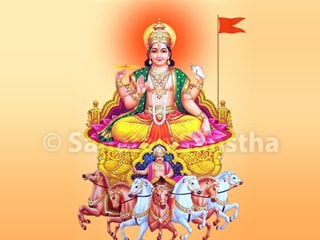 Ratha Saptami 2025
Ratha Saptami 2025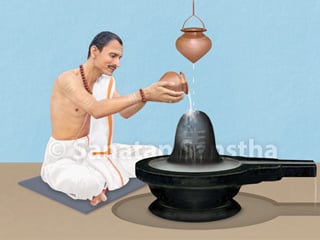 Mahashivratri 2025
Mahashivratri 2025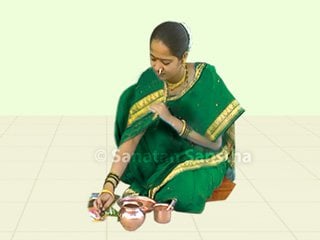 Importance of Adhik maas (Purushottam maas)
Importance of Adhik maas (Purushottam maas)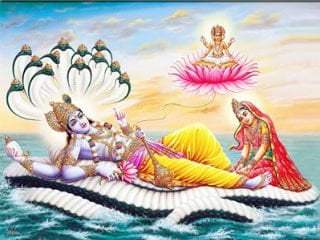 Vaikunth chaturdashi is an invaluable opportunity granted to us to worship Deity Shri Vishnu
Vaikunth chaturdashi is an invaluable opportunity granted to us to worship Deity Shri Vishnu How to celebrate Navaratri in adverse times caused by coronavirus pandemic ?
How to celebrate Navaratri in adverse times caused by coronavirus pandemic ?
I am reading a Hindi book titled Vrat aur Tyohaar.
There is repeated use of the term Ujadna. What does it mean? Eg. In this particular vrat, ujadna says – Feed 31 or 1 Brahmin couple and give them Dakshina.
What exactly is this word? Will you be able to help?
Namaste,
Is the book, that you are reading, a Sanatan’s publication? If yes, can you share the edition, page number?
Namaste, due to carelessness I ate during ongoing Navratri fast (on the 6th day). How should I make-up for this loose action. Kindly advise.
Namaskar,
If you ate by mistake, then you can seek forgiveness from the Deity, and chant the name of the Deity as atonement.
Can you please tell me what kind of food should we eat during Navratri? Cooked or uncooked? How many times a day can we eat? Can we eat fried foods such as fried potatoes chips? Saboodana ki sabji? Roasted peanuts? How much should we eat? Please explain 🙏
Namaskar,
Generally fast means skipping the meals, either any one meal or both. You can eat fruits or cooked food like sabudana khichdi, potato vegetable or chips etc. You can decide once as per your convenience what to skip and what to eat, and then follow it till the period of vrat that you have decided to observe.
Namaste,
I started kedar gowri vrat for 21 days. Today is my 13th day vrat. But I got my menses today, within 16 days after my previous menses. I am confused what to do now. Can i continue? Or can my husband continue for me?Kindly advise.
Namaskar,
In such a case your husband can continue the vrat.